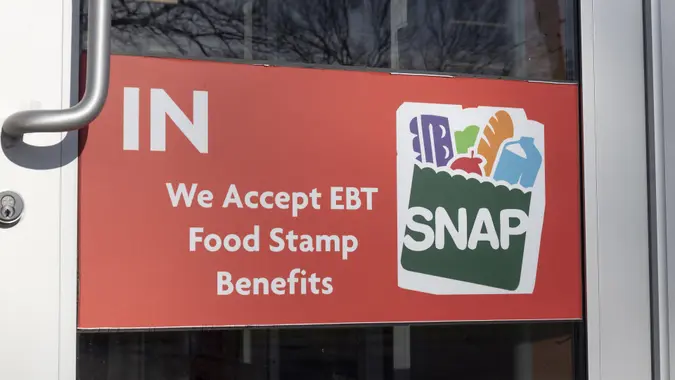6 Reasons To Expect a Strong Economy in 2025 (and 4 Not To)

Commitment to Our Readers
GOBankingRates' editorial team is committed to bringing you unbiased reviews and information. We use data-driven methodologies to evaluate financial products and services - our reviews and ratings are not influenced by advertisers. You can read more about our editorial guidelines and our products and services review methodology.

20 Years
Helping You Live Richer

Reviewed
by Experts

Trusted by
Millions of Readers
The U.S. stock market has had two big back-to-back years, topping a 20% return for both 2023 and 2024. Gains in 2024 accelerated after President-elect Donald Trump won re-election in November, pushing the market to record highs.
As the stock market is known as a “forward-looking mechanism,” generally trading based on where the economy will be six months down the road, things seem to bode well for future growth.
But while there are plenty of indicators that the economy will be strong in 2025, there are also some that suggest potential weakness. Here’s a look at both sides of the argument.
Reasons To Expect a Strong Economy in 2025
These are the top reasons given by economists and financial analysts as to why the economy may remain strong in 2025:
- The Bloomberg consensus estimate projects the U.S. economy will grow at an annualized rate of 2% in 2025, with some experts, like the head of Bank of America’s economics team Claudio Irigoyen, calling for a 2.4% growth rate.
- Consumer confidence is the highest it has been since July 2023, with the Consumer Conference Board’s Index reaching 111.7 in November. It typically takes a reading of 80 or lower to signal an upcoming recession.
- U.S. economic output, as measured by S&P Global’s flash US composite PMI, reached 55.3 in November, the highest reading since April 2022. This signifies greater optimism among businesses in the services and manufacturing sectors.
- Retail sales topped estimates in October, an important indicator as consumer spending is one of the key engines of the overall economy.
- The unemployment rate is holding steady at approximately the 4.1% mark, indicating full employment.
- The inflation rate continues to slowly trend towards the Federal Reserve’s target of 2%, reaching 2.6% in October. This is well below the peak inflation rate of 9.1% in 2022.
Causes for Potential Concern
While many economic indicators seem to suggest that the U.S. has the wind at its back, there are areas for potential concern.
Here are some of the reasons that the projected economic growth scenario may not play out in 2025:
The Election Cycle
While stocks tend to run up leading into an election — and 2024 was no different — the first year after an election is often a different story.
Historically, markets don’t do well in the 12-month periods following elections. Not coincidentally, according to the National Bureau of Economic Research, about 54% of 12-month periods following elections overlapped recessions.
The Level of the U.S. Stock Market
According to Ned Davis Research, the sheer number of new highs the market has made in 2024 could spell trouble for 2025.
The firm’s research shows that when the market makes at least 35 new highs in a given year, its returns the next year average just 5.8% — well below the long-term average of 8%-plus. Coupled with the two banner years just posted by the stock market, some strategists are showing concern for 2025.
Historic S&P 500 Returns in Slow-Growth Environments
Past performance does not guarantee future results, but historically speaking, the stock market doesn’t perform very well when the economy slows.
According to data from RBC Capital Markets, when GDP comes in between 1.1% and 2%, the S&P 500 averages a 3.4% decline. When GDP falls to the 0.1% to 1.0% range, things are even worse, with the S&P dropping an average of 17.1%.
This suggests that if the economy doesn’t hit projected growth targets, the market could suffer mightily.
Trump’s Promised Tariffs
One of the biggest headwinds facing the market is the implementation of President-elect Trump’s proposed tariffs. Although it’s anybody’s guess exactly what tariffs Trump will seek to enact once he takes office, he has spoken of tariffs of 25% on Mexican and Canadian goods and up to 60% on Chinese products.
In a Dec. 8 televised interview with “Meet the Press,” Trump even admitted that he “can’t guarantee” that these tariffs would make prices go up for American consumers. If tariffs bring back inflation, it could be a serious problem for the 2025 economy.
The Bottom Line
The direction of the U.S. economy is notoriously difficult to predict. In fact, in 1982, MIT Professor Paul Samuelson famously quipped that “the stock market has predicted nine out of the last five recessions,” indicating how investor sentiment, as seen in stock prices, can be more emotional than predictive.
The key for most investors is to maintain a long-term outlook and to rebalance portfolios when they get out of whack.
Editor’s note on election coverage: GOBankingRates is nonpartisan and strives to cover all aspects of the economy objectively and present balanced reports on politically focused finance stories. You can find more coverage of this topic on GOBankingRates.com.
More From GOBankingRates
 Written by
Written by  Edited by
Edited by 

























